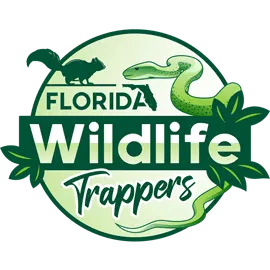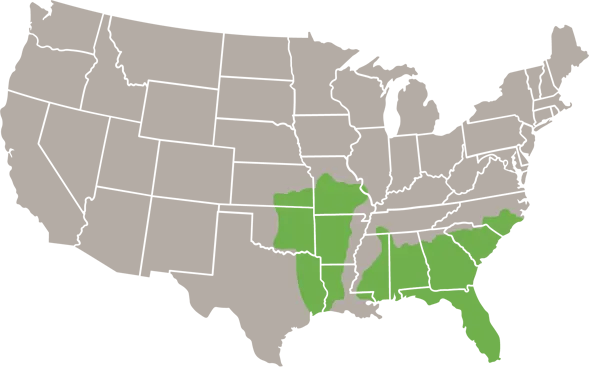Scarlet Snake
- Scientific Name
- Cemophora coccinea
- Also Known As
- Northern scarlet snake
- Range
- All of Florida
- Diet
- Lizards, Small Rodents, Eggs
- Life Expectancy
- 8 Years
Quick Links
The Scarlet Snake in Central Florida
The scarlet snake (Cemophora coccinea) is a common yet secretive snake inhabiting central Florida. Often confused with the venomous coral snake, the scarlet snake is a harmless and beneficial reptile that preys on lizards, snakes, and rodents. This comprehensive guide provides detailed identification tips, biology facts, and information on scarlet snake habits and habitat preferences in central Florida.
Read on to learn scarlet-snake characteristics, behavior, reproduction, ideal environment, diet, and prevention of accidental bites.
Scarlet Snake Subspecies in the Area

Photo 192418160 © Anthony, CC BY-NC
Florida Scarlet Snake
The Florida scarlet Snake (Cemophora coccinea coccinea) is a unique subspecies found only in Florida’s southern peninsula. Genetic isolation has led to distinct traits like their bright red belly coloration. They also have divided anal plate scales and grow under 20 inches long. Living in scrub and sandhills, their adaptations suit the habitat, like small size for hunting lizards in sandy soils. Loss of scrub habitat has greatly reduced their limited range.
Calling them a distinct subspecies stresses the need for habitat protection. Preserving Florida’s remaining scrub is critical for the scarlet Snake’s survival. Recognizing their status draws attention to their decline from habitat destruction. Protecting scrub allows this rare Florida subspecies to persist within its small isolated range.
Appearance and Identification
Scarlet snakes can be identified by their distinct color pattern and morphological features
Scarlet snakes can be differentiated from the venomous coral snake by remembering “red touch yellow, kill a fellow; red touch black, venom lack.” In scarletsnakes, the red bands touch the black bands.
Maturation Rate
Young scarlet snakes grow quickly, reaching adult size by 2-3 years old. Hatchlings shed their skin frequently as they grow, allowing them to grow several inches in the first year. The maturation rate depends on food availability and climate, proceeding more slowly in harsher conditions.
Habits and Behavior
Scarlet snakes are terrestrial, nocturnal snakes that spend much of their time underground. They prefer sandy habitats with loose soil for burrowing, emerging at night to hunt lizards, smaller snakes, eggs, and rodents. When threatened, scarlet snakes may vibrate their tails rapidly, releasing a pungent musk. This serves to startle predators while allowing the snake to retreat underground.
Scarletsnakes are not aggressive, preferring to hide or flee from threats. They rarely bite even when handled. The docile nature, small size, and bright colors have made scarlet-snakes popular as pets, though they are better left in the wild.
Reproduction and Lifespan
Scarlet snakes reach sexual maturity by 2-3 years old. Breeding takes place in spring after emerging from winter dormancy. Males locate females by following pheromone trails. After mating, females lay 3-12 eggs in early summer in loose soil or under rocks and logs. The eggs hatch around 2 months later in late summer. Hatchlings grow rapidly and are independent immediately.
Scarlet snakes may live up to 8 years in the wild. Predators include birds of prey, larger snakes, and mammals. Their cryptic habits help compensate for the visible coloration.
Ideal Habitat and Range
Central Florida’s subtropical climate provides an ideal habitat for scarlet snakes. Average temperatures range from the 60s to 70s°F (15-25°C) in winter to over 90°F (32°C) in summer. Annual rainfall totals near 50 inches (1270 mm), supporting sandy soils and loose leaf litter. Vegetation includes pine flatwoods, scrub, sand pine scrub, and xeric oak hammocks interspersed with swamps and marshes.
Scarlet snakes thrive in warm, humid conditions. Sandy soils with plentiful ground cover allow them to easily burrow and find insect and small vertebrate prey. Development has reduced optimal habitat, though scarlet snakes persist in conservation lands, parks, and suitable marginal areas. Their secretive nature keeps them inhabiting suburban yards and farms unnoticed.
Diet and Feeding
Scarlet snakes are carnivorous, consuming a diet of:
- Lizards – skinks, anoles, geckos
- Small snakes – worm snakes, ringneck snakes
- Rodents – mice, small rats
- Bird eggs and hatchlings
- Large insects – caterpillars, beetle larvae
They hunt at night on the ground surface and underground. Scarlet snakes locate prey using chemical cues detected by flicking their forked tongue. They swallow prey whole, using their flexible jaws and teeth to grip and maneuver food into the esophagus. Food passes through quickly, allowing them to eat again soon after feeding.

Photo 59880214 © J.D. Willson, CC BY-ND

Common Health Risks
While scarlet snakes rarely bite, they should not be handled. Bites can cause the following:
- Mild pain, bleeding from small puncture wounds
- Local swelling and redness
- Low risk of infection
Bites are not medically significant. Antibiotics and basic wound care suffice for treatment. The biggest risks from scarlet snakes come from accidentally killing them, resulting in a $100 fine in Florida. Homeowners should learn to identify local snakes to avoid destroying harmless, beneficial species.
Preventing Conflicts with Scarletsnakes
Scarlet snakes want to avoid contact with humans and pets. Some tips include:
- Keep areas around foundations clear of debris that provides shelter
- Seal cracks and holes where snakes enter buildings
- Supervise small pets outdoors
- Don’t reach into areas you can’t see clearly
- Call a professional for removal if found indoors
If encountered, remain calm and allow the snake to retreat. Scarlet snakes play an important role in controlling rodents, insects, and other snakes. Relocating them away from homes is better than killing them.
Scarlet snakes in Central Florida – Conclusion
The scarlet snake is one of central Florida’s most colorful reptiles, yet often goes unseen due to its small size and secretive habits. Its importance in controlling pests makes the scarlet snake a species to appreciate and coexist with responsibly. Through habitat preservation and learning proper identification, central Floridians can foster an appreciation for the scarlet snake and other harmless native snakes that form vital links in local ecosystems.






